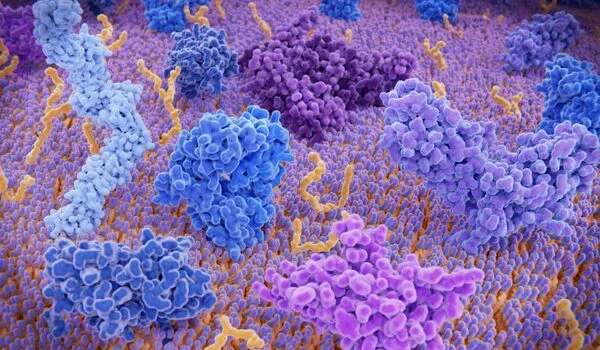Nanoparticles have been extensively researched for their potential in cancer treatment, particularly for directly delivering therapeutic agents to tumors. Nanoparticles have the advantage of being able to be engineered to specifically target cancer cells while avoiding healthy cells, lowering the risk of side effects. Certain nanoparticles have also been shown in recent research to stimulate an immune response against tumors. This is due to the fact that nanoparticles can act as adjuvants.
Researchers discovered that when immunostimulatory drugs known as imidazoquinolines are delivered using specialized bottlebrush nanoparticles, the drugs stimulate the immune system to attack tumors while avoiding the side effects that occur when the drugs are given alone.
Cancer drugs that stimulate the immune system to attack tumors are a promising treatment option for many types of cancer. However, some of these drugs cause excessive systemic inflammation when administered intravenously, making them dangerous to patients.
MIT researchers have now proposed a possible solution to this problem. In a new study, they demonstrated that when immunostimulatory prodrugs (inactive drugs that must be activated in the body) are tuned for optimal activation timing, the drugs stimulate the immune system to attack tumors without the side effects associated with the active form of the drug.
Our ability to synthesize six bottlebrush prodrugs with identical sizes and shapes uniquely allows us to isolate and study release kinetics as a key variable. Excitingly, we find that it is possible to identify prodrug structures that limit IMD exposure to the whole body, thereby avoiding toxicity, and that activate in tumors to give antitumor efficacy.
Jeremiah Johnson
Based on a class of compounds known as imidazoquinolines, the researchers created prodrugs with bottlebrush-like structures. Mice treated with these optimized activation kinetics bottlebrush prodrugs showed a significant reduction in tumor growth with no side effects. The researchers hope that by combining this approach with other immunotherapy drugs or cancer vaccines, they will be able to boost immune system responses in cancer patients.
“Our bottlebrush prodrug library enabled us to show an immunological effect of controlling immunotherapy kinetics, allowing us to boost immune responses while minimizing the side effects,” says Sachin Bhagchandani, an MIT graduate student who is the lead author of the study. “This kind of approach opens up avenues for scientists who want to decouple toxicity from some promising immunotherapy agents.”
Jeremiah Johnson, an MIT professor of chemistry, and Darrell Irvine, the Underwood-Prescott Professor with appointments in MIT’s departments of Biological Engineering and of Materials Science and Engineering, are the senior authors of the paper, which appears today in Science Advances. Irvine is also an associate director of MIT’s Koch Institute for Integrative Cancer Research and a member of the Ragon Institute of MGH, MIT, and Harvard.

Nanoparticles provoke immune response against tumors but avoid side effects
Tailored prodrugs
IMDs are organic molecules that bind to cell receptors called Toll-like receptors found on macrophages and other innate immune system cells. When these cells are activated, they begin to produce cytokines and other inflammatory molecules.
The FDA approved topical IMD drugs to treat certain types of skin cancer in 1997. Many other IMD drugs have since been tested in clinical trials for a variety of cancers, but none have been approved, in part because the drugs caused too much systemic inflammation.
The MIT researchers wanted to see if prodrugs of IMDs, which are inactive until turned “on” in the tumor microenvironment, could help reduce those side effects. Johnson’s lab has recently developed a novel type of prodrug platform shaped like a bottlebrush. These nanoscale, cylindrical structures are made up of chains that branch out from a central backbone, giving the molecule a bottlebrush shape. Cleavable linkers that define the rate of active IMD release bind inactivated drugs along the bottlebrush backbone.
The researchers generated and compared six bottlebrush prodrugs that only differed by their release rate, in order to investigate how prodrug activation kinetics impact antitumor responses. Using these bottlebrush prodrugs, the researchers hoped they could deliver active IMDs to tumors while avoiding release into the bloodstream.
“Our ability to synthesize six bottlebrush prodrugs with identical sizes and shapes uniquely allows us to isolate and study release kinetics as a key variable. Excitingly, we find that it is possible to identify prodrug structures that limit IMD exposure to the whole body, thereby avoiding toxicity, and that activate in tumors to give antitumor efficacy,” Johnson says.
In preliminary studies in cells and mice, the researchers found that the fastest-activating prodrugs did cause immune-related side effects, including weight loss and elevated cytokine levels. However, the medium- and slow-releasing versions did not produce these effects.
The IMD bottlebrush prodrugs were then tested in two different mouse models of colon cancer. Because the prodrugs are so small (about 10 nanometers), they can accumulate efficiently in tumors. They are taken up by innate immune cells and their linkers are cleaved. The subsequent release of active IMDs causes immune cells to release cytokines and other molecules that promote inflammation. This chain of events causes nearby T cells to attack the tumor.
The bottlebrush prodrugs significantly slowed tumor growth in both models of mice. Tumors were completely eliminated in approximately 20% of the mice when the treatment was combined with a checkpoint blockade inhibitor, another type of immunotherapy drug. While mice given the IMD used in this study, resiquimod, showed weight loss, elevated cytokine levels, and a decrease in white blood cell count, mice given resiquimod bottlebrush prodrugs showed none of these effects.
“Our molecules were able to safely reduce these effects by controlling how much of the active drug is released in the blood,” says Bhagchandani. “If you minimize release of the active compound there, then you’re able to get anti-tumor effects at the tumor site without the systemic side effects.”





